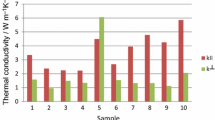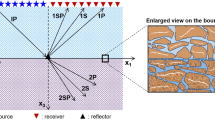Abstract
The pH-dependence of glass corrosion rates has a well-known U-shaped form with minima for near-neutral solutions. This paper analyses the change of U-shaped form with time and reveals that the pH dependence evolves even for solutions that have pH not affected by glass corrosion mathematically corresponding to a zero surface to volume ratio. The U(t) dependence is due to changes of concentration profiles of elements in the near-surface layers of glasses in contact with water and is most evident within the initial stages of glass corrosion at relatively low temperatures. Numerical examples are given for the nuclear waste borosilicate glass K-26 which is experimentally characterised by an effective diffusion coefficient of caesium \({{\text{D}}_{{{\text{C}}_{\text{s}}}}} = 4.5{\text{} }{10^{ - 12}}\) cm2/day and by a rate of glass hydrolysis in non-saturated groundwater as high as rh = 100 nm/year The changes of U-shaped form need to be accounted when assessing the performance of glasses in contact with water solutions.
Similar content being viewed by others
References
C.M. Jantzen, W.E. Lee, M.I. Ojovan. Radioactive Waste Conditioning, Immobilisation, and Encapsulation Processes and Technologies: Overview and Advances. Chapter 6 in: W.E. Lee, M.I. Ojovan, C.M. Jantzen. Radioactive waste management and contaminated site clean-up: Processes, technologies and international experience. p. 171–272, Woodhead, Cambridge (2013).
S. Gin, A. Abdelouas, L.J. Criscenti, W.L. Ebert, K. Ferrand, T. Geisler, M.T. Harrison, Y. Inagaki, S. Mitsui, K.T. Mueller, J.C. Marra, C.G. Pantano, E.M. Pierce, J.V. Ryan, J.M. Shoefield, C.I. Steefel, J.D. Vienna. An international initiative on long-term behaviour of high-level nuclear waste glass. Materials Today, 16 (6) 243–248 (2013).
A. Chroneos, M.J.D. Rushton, C. Jiang, L.H. Toukalas. Nuclear wasteform materials: Atomistic simulation case studies. J. Nucl. Mater., 443, 29–39 (2013).
G. Wicks. Nuclear waste vitrification–The geology connection. J. Non-Crystalline Solids, 84 241–250 (1984).
Statistical Calculation and Development of Glass Properties. {rs http://glassproperties.com/}url} (accessed on 21.05.2014).
D. Bacon, E. Pierce. Development of long-term behaviour models for radioactive waste forms. Chapter 14 in: M.I. Ojovan. Handbook of advanced radioactive waste conditioning technologies. ISBN 1 84569 626 3. Woodhead, Cambridge, p.433–454 (2011).
D.H. Bacon, B.P. McGrail. Waste form release calculations for performance assessment of the Hanford immobilized low-activity waste disposal facility using a parallel, coupled unsaturated flow and reactive transport simulator. Mat. Res. Soc. Symp. Proc. 757, II1.9.1–6 (2003).
M.I. Ojovan, R.J. Hand, N.V. Ojovan, W.E. Lee. Corrosion of alkali-borosilicate waste glass K-26 in non-saturated conditions. J. Nucl. Mater. 340, 12–24 (2005).
M.I. Ojovan, A.S. Pankov, W.E. Lee. The ion exchange phase in corrosion of nuclear waste glasses. J. Nucl. Mater., 358, 57–68 (2006).
D.H. Bacon, M.I. Ojovan, B.P. McGrail, N.V. Ojovan, I.V. Startceva. Vitrified waste corrosion rates from field experiment and reactive transport modelling. Proc. ICEM ‘03: The 9th International Conference on Radioactive Waste Management and Environmental Remediation, September 21–25, 2003, Examination School, Oxford, England, 7p., CD ROM 4509.pdf. (2003).
M.I. Ojovan, W.E. Lee. An Introduction to Nuclear Waste Immobilisation, Second Edition, Elsevier, 2nd Edition, Amsterdam, 362 p. (2014).
D.M. Strachan. Glass dissolution: testing and modeling for long-term behavior J. Nucl. Mater., 298, 69–77 (2001).
W.L. Ebert. The effect of the leachate pH and the ratio of glass surface area to leachant volume on glass reactions. Phys. Chem. Glasses, 34 (2) 58–65 (1993).
M.I. Ojovan, W.E. Lee, A.S. Barinov, I.V. Startceva, D.H. Bacon, B.P. McGrail, J.D. Vienna. Corrosion of low level vitrified radioactive waste in a loamy soil. Glass Technol., 47 (2), 48–55 (2006).
B. Grambow. A general rate equation for nuclear waste corrosion. Mat. Res. Soc. Symp. Proc. 44, 15–27 (1985).
A.A. Belyustin, M.M. Shultz. Interdiffusion of cations and concomitant processes in near surface layers of alkali-silicate glasses treated by water solutions. Physics and Chemistry of Glass, 9, 3–27 (1983).
Z. Boksay, G. Bouquet, S. Dobos, The kinetics of the formation of leached layers on glass surfaces, Phys. Chem. Glasses, 9, 69–71 (1968).
P. Melling, A. Allnatt. Modelling of leaching and corrosion of glass, J. Non-Cryst. Solids, 42, 553–560 (1980).
Author information
Authors and Affiliations
Rights and permissions
About this article
Cite this article
Ojovan, M.I., Lee, W.E. About U(t) form of pH-dependence of glass corrosion rates at zero surface to volume ratio. MRS Online Proceedings Library 1744, 153–161 (2014). https://doi.org/10.1557/opl.2015.332
Published:
Issue Date:
DOI: https://doi.org/10.1557/opl.2015.332




